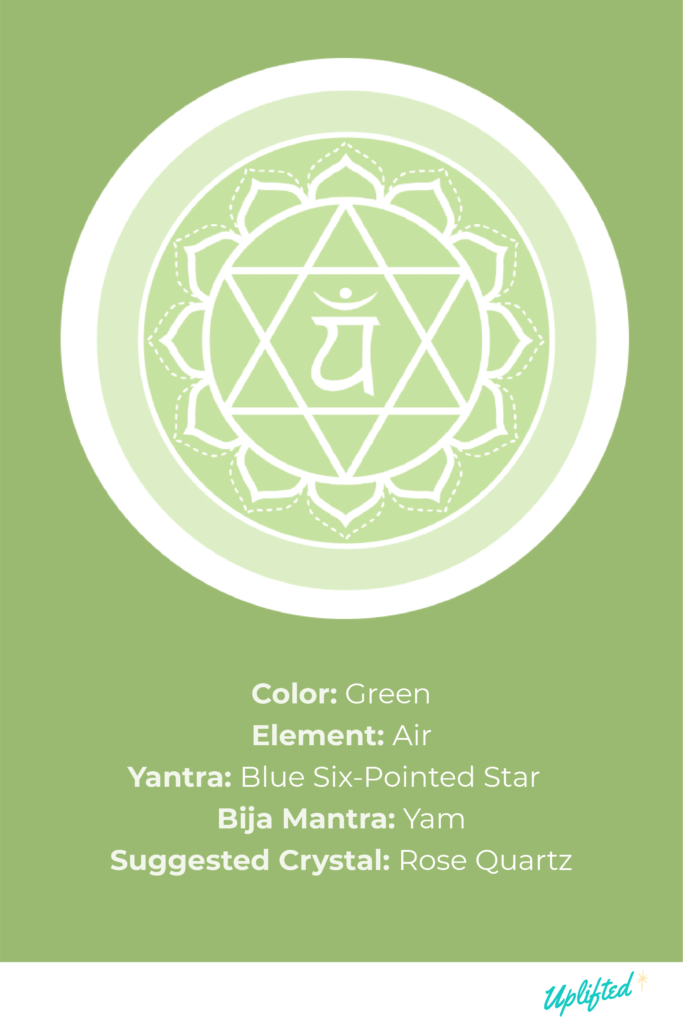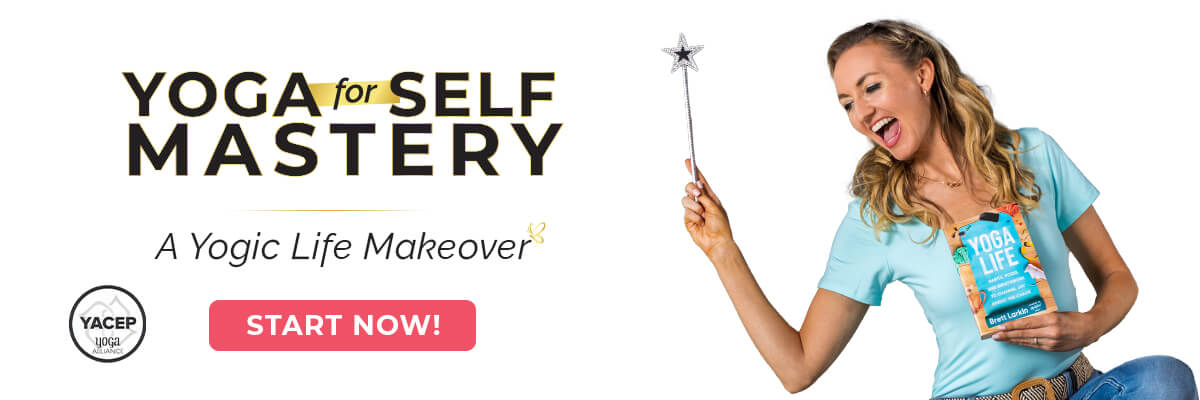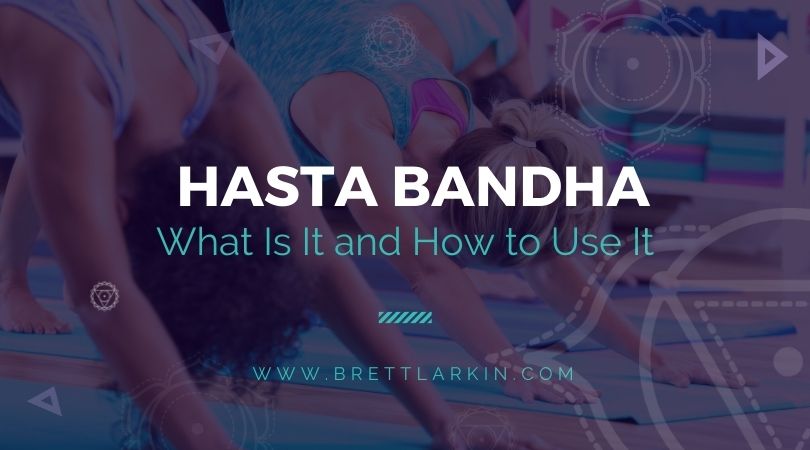
Have you ever been in yoga class and heard your teacher talk about bandhas? Maybe in downward dog mentioning the hasta bandha?
If you’ve ever wondered what the heck they mean when they say this, you’re in luck because that’s what we’ll be talking about here!
A quick rundown on bandhas in general: the Sanskrit word bandha signifies the “lock”. The bandhas can engage the prana and guide it through the Nadis towards the areas of the body that need it the most. This then does all sorts of good stuff for your body. (We’ll get into that a little more later.)
There are three major bandhas: throat lock or chin lock (jalandhara bandha), abdominal muscles lock (uddiyana bandha), and root lock (mula bandha). Then there is maha bandha (great lock) and two minor bandhas: hand lock (hasta bandha) and foot lock (pada bandha).
In this blog post we’ll focus on hasta bandha. What it means, where it is in your body, its benefits, and how to practice it.
What is Hasta Bandha?
The hasta bandha is the hand lock. It involves activating the hands by pressing your hands to the ground in poses like in downward dog.
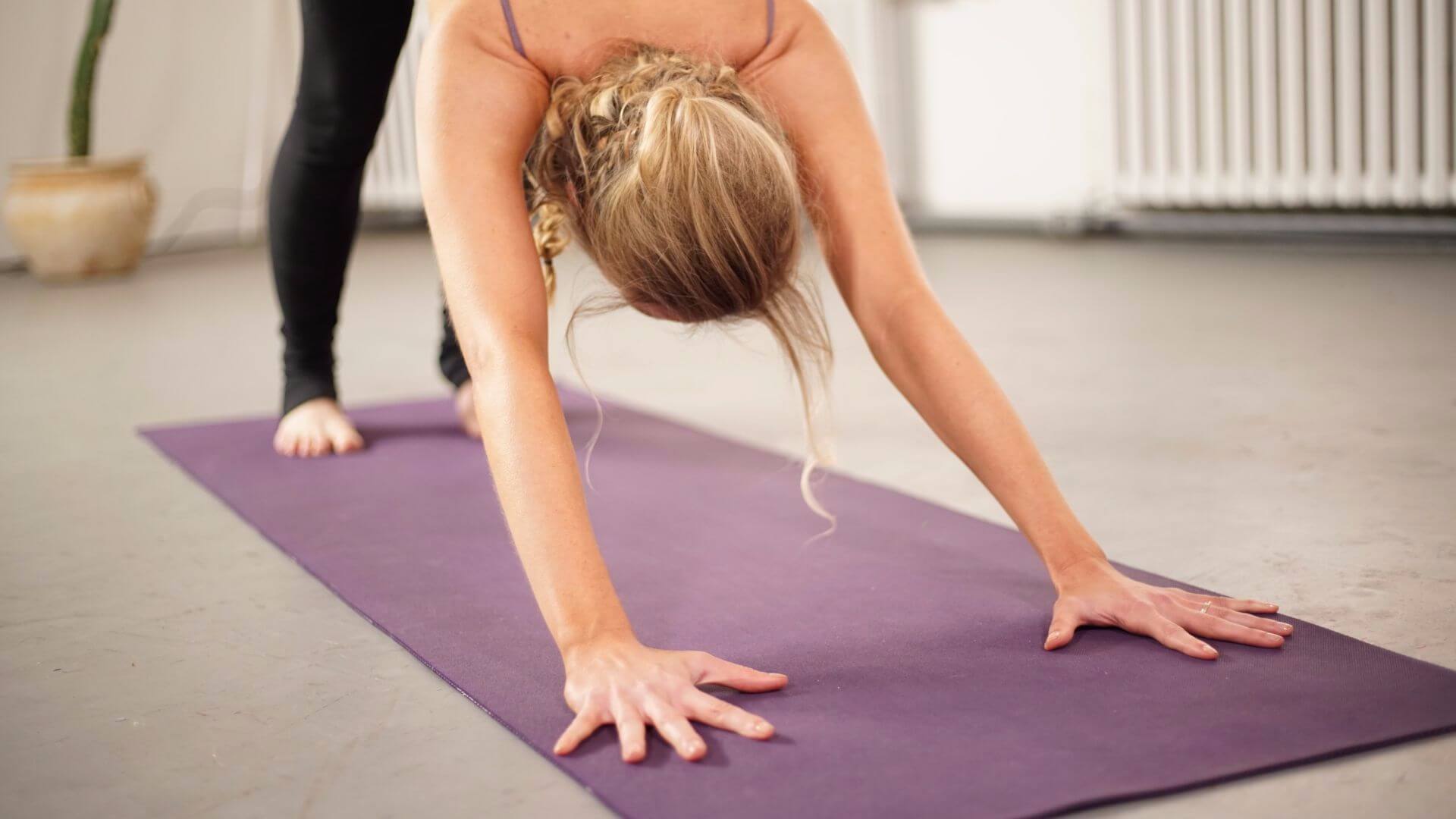
Placing hands on the ground can be a new and demanding experience especially for beginner yogis (sore wrists, anyone?). Learning how to engage hasta bandha can substantially improve your yoga asana, and make challenging poses, such as arm balances and inversions, accessible to new and practiced yogis alike.
Hasta Bandha Meaning
Hasta bandha appears in the textbooks as the grounding of the hands. The term directly translates from Sanskrit to the “hand lock” as hasta means hand and bandha means lock. During this grounding, the fingers spread apart and the center of the palm elevates due to the cupping action.
The Physical Hasta Bandha
To physically access hasta bandha, place your hands on the mat, spread your fingers wide to create a wide support base and root down through all your knuckles.
Try to bring most of the weight towards the bases of your pointer and thumb fingers, by internally rotating your forearms.
Maintain a gentle grip with the rest of the fingers while keeping all your knuckles grounded.
To amplify your hand’s engagement, initiate an internal movement of one hand towards the other while lifting the center of the palm like a suction cup.
The Subtle Hasta Bandha
As with all of the bandhas, the hand lock is more than proper alignment. Yes, we’re talking subtle body, yogis!
When you’re activating this bandha, it should feel like you are drawing energy upwards through the hands. The energetic “pull” from hasta bandha manifests in annamaya kosha (our physical layer) with the way we position our bodies and pranamaya kosha (our energy layer) with the chakras.
In yoga, the arms are understood as organs of expression for the heart’s desire, or anahata chakra. So, by energetically awakening the arms and shoulders through activating hasta bandha, we bridge the connection between the physical and subtle layers.
It’s through this connection that we can discover the nature of imbalance in the heart chakra that may be preventing the flow of prana through sushumna nadi (the primary energetic channel running along the spine).
Why Practice Hasta Bandha
Practicing hasta bandha is a great way to deepen the connection to your yoga poses. The hasta bandha draws energy up from the earth and redirects it to the rest of your body.
To help explain why this bandha is so useful to practice, these are some of the many benefits that can come from practicing hasta bandha.
Strengthen the Arms
Practicing Hasta Bandha will enhance the strength of the muscles, ligaments, joints, and connective tissue throughout your arms because you’re consciously engaging them. This is especially true and valuable for weight-bearing postures where engaging the arms is crucial such as plank, arm balances, and inversions.
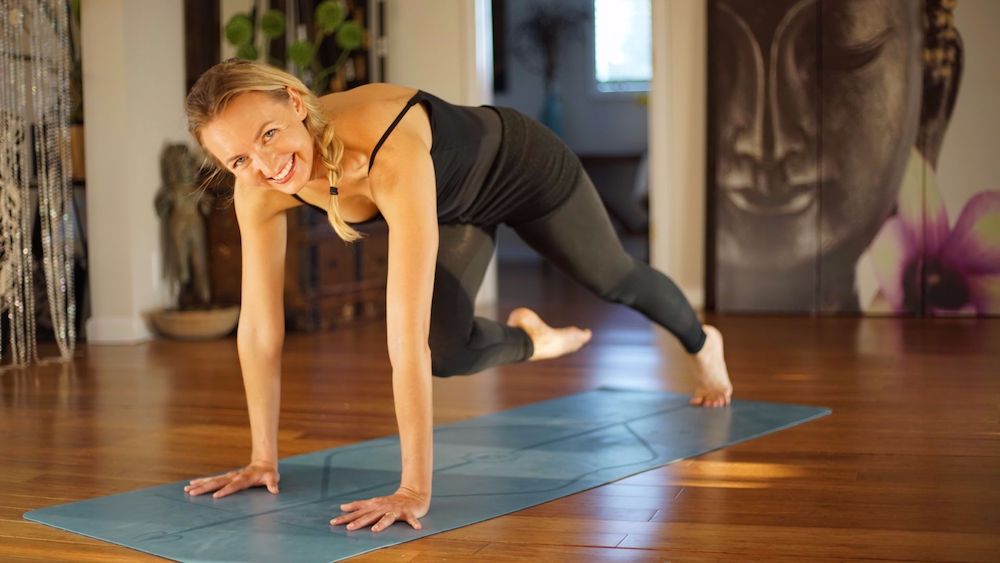
Use this interactive diagram of the hand to identify specific parts and see how the hands are anatomically connected to the shoulders and spine.
Injury Prevention
Activating hasta bandha supports awareness of the physical body. Over time, you’ll get used to recognizing the different muscles in your arms and strengthen the supporting muscles that help prevent injury.
Access to Anahata Chakra
Hasta bandha leads directly up your arms to your chest and anahata chakra, which can give you added strength to access that chakra.
Unblocking the anahata chakra (heart chakra) will enable you to act from a position of love, compassion, and interconnectedness. When your heart chakra is open, you’ll be able to handle life challenges with greater confidence and see the beauty around you and in yourself. The anahata chakra can guide you towards unconditional self-love and acceptance.
Sounds like a pretty good deal, right?
Increases awareness
Your ability to tap into your bandhas and the energetic world will support your physical, mental, emotional, and spiritual awareness. Consequently, that may expedite the advancement of your yoga technique.
How to Use Hasta Bandha in Yoga Poses
To gain a better understanding of its application, let’s explore the engagement of hasta bandha in downward dog.
- Start on all fours, gently activating your core and lifting your pelvic floor
- Place your hands shoulder-distance apart, and spread your fingers evenly to create a supportive base for your upper body.
- Tuck your toes under and lift your hips towards the sky for downward dog. As you lift your tailbone, keep your feet rooted hip-width distance apart, core engaged, and your pelvic floor lifted. Evenly distribute your body’s weight between the upper and lower body.
- Bend your legs if needed, while trying to maintain a straight spine.
- The base of your thumbs and index fingers should carry the most weight.
- The core of your palm is lifted to create a concave shape.
- Turn your elbows to face the ground to broaden your shoulders.
- Your neck should be aligned with the rest of your spinal column, while at the same time you lengthen the crown of your head towards the earth, and keep your chin in towards your sternum.
- Hold the posture for 5-10 rounds of breath
Modifications
- Place the palms of your hands on blocks, on a wall or a chair, to make the pose more accessible.
- Fold the end of your mat or place a folded blanket under your heels to reinforce your pada bandha.
- Place a strap above the elbows to ensure correct shoulder-distance hand placement.
Progressions
Hasta bandha is the root of all arm balances in yoga, whether you’re working in tabletop, downward dog, forearm balance, or handstand. To get into more challenging arm balances, apply steps 1-9 above and slowly load more weight into the hands. Focus more on the energetic sensations of your hands gripping the mat, your shoulders drawing gently together to open your heart, and the gentle hug of arms and legs toward center than what the pose looks like.
You may choose to integrate mula bandha, jalandhara bandha, and pada bandha, in your downward dog (or arm balances) to intensify these sensations.
Using the Hand Lock with Hypermobility
The term ‘hypermobility’ refers to the increased range of motion of some or all joints. It’s more widespread in childhood and adolescence and it naturally decreases with age. (If you could do the splits when you were a kid but now couldn’t even comprehend the idea, you know what I mean!)
Hypermobile people experience little or no pain when they exceed the ‘normal’ range of movement, which can lead to a lack of control. The looseness of the ligaments that hold the joints in place can lead to joint dislocation or muscle tearing.
Yoga asana is designed to bring strength, mobility, awareness, and balance to the practitioner. Hypermobile yogis should focus on strengthening the muscles that surround the ‘looser’ joints to stabilize them and work on increasing proprioception (the awareness of where the body is in space).
That being said, in postures where the hands hold most of the body’s weight, the engagement of hasta bandha should be one of the absolute priorities to maintain a safe and lasting practice.
My Wrists Still Hurt! What Do I Do?
If you experience wrist pain during your yoga practice, it’s important to identify when the pain occurs. If it starts at the beginning, you may want to invest some time warming up your hands and forearms before you dive into your practice. If it starts in the middle or at the end, then you probably lost the activation of hasta bandha, and the excess weight starts being a burden on your wrists.
Here are some modifications that could alleviate wrist pain and tight shoulders.
1. Prop up your palms, to reduce the angle between your hand and forearm. This will take pressure off of your wrist joints.

To prop your hands, you can use a folded towel or blanket, or wrist wedges designed for this. Put your props at the top of your mat and place the base of your palms on them when your hands meet the ground. Spread your fingers, and firmly ground the knuckles of your thumbs and index fingers.
2. Use fists, to provide a solid base for your upper body and eliminate the angle between the hands and forearms. Remove any rings before you try this!
Create a fist with your hands with the thumbs free. Place your fists knuckle-down onto the mat, stacking wrists directly over them and activating your forearms.
3. Place your forearms on the mat, keeping them shoulder-width apart. For greater balance, interlace all fingers or keep your forearms and hands parallel to each other and actively press your hands on the mat. To increase the challenge, have your palms facing up.
4. If you’re not sure about a posture or feel pain, skip it and find child’s pose instead. Some postures may simply not work if you have a wrist injury or general sensitivity.
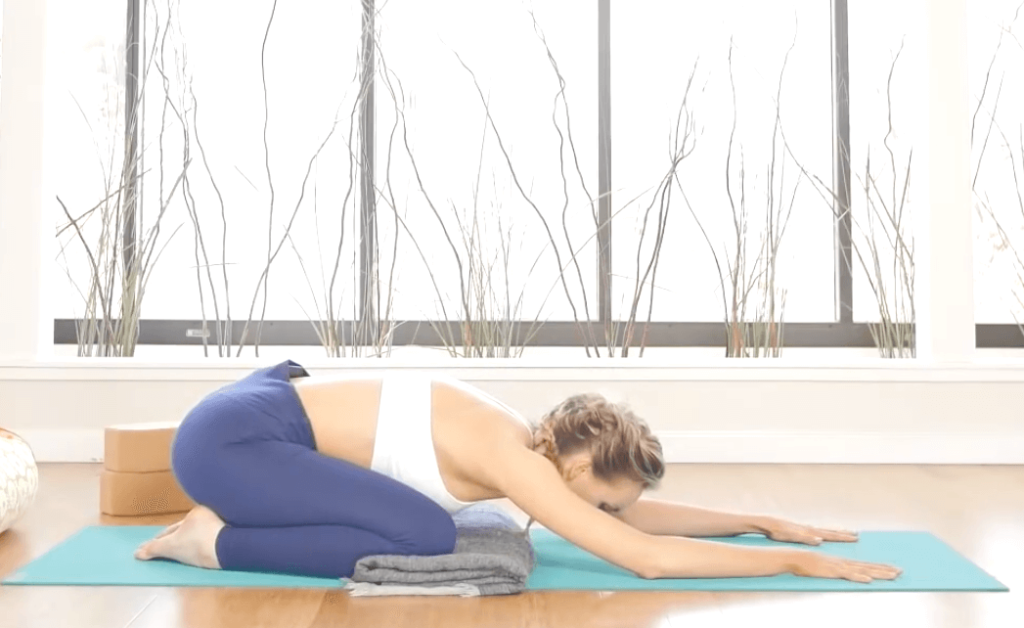
Hasta Bandha Contraindications
Carpal Tunnel Syndrome
Putting weight on hands that suffer from carpal tunnel syndrome may seem like a bad idea. However, in mild cases, yoga postures can alleviate aches and discomfort. Practicing hasta bandha can reinforce the muscles of the forearms and increase stability. In severe cases of carpal tunnel syndrome, you should consult your healthcare provider before practicing hasta bandha.
Frozen shoulder or shoulder injury
In cases of a shoulder injury, such as shoulder dislocation or exacerbation, consult your healthcare provider before practicing hasta bandha. If you get the all-clear, focus on strengthening the muscles around the shoulders, enhance the balance of the rotator cuff muscle, and avoid any postures that promote flexibility of the shoulder or put extra weight on it.
Next Steps
- Take my History of Yoga Course to learn all about yogic principles and how they are applied to daily life!
- Order my Yoga Life book for a practical guide to applying yogic principles to your life and constitution.
- Check out my Yoga Philosophy knowledge hub for more inspiring content
- Join Uplifted for exclusive content that you can access right from the app. Take a deep dive into your practice with me this year!
Experience 3 Training Videos from Inside My 200-Hour Online YTT

YOU MIGHT ALSO LIKE
- Uddiyana Bandha: Tapping Into Your Deep Core
- 4 Reasons Hasta Bandha Is Essential To Your Yoga Practice
- What is Mula Bandha and How to Practice It
- Jalandhara Bandha: 4 Reasons Yogis of All Levels Should Practice It
- Pada Bandha: Your #1 Secret to Happy Feet
- The 6 Ancient Yoga Bandhas (And How To Engage Them)
Learn how to do 11 of the most popular yoga poses correctly. Free video + PDF download.


